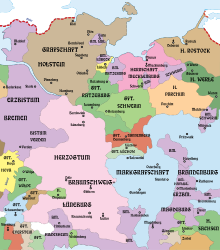County Wölpe
|
|
|
|---|---|
| The county of Wölpe (green area in the red circle) around 1250 |
In the Middle Ages, the county of Wölpe was the dominion of a noble family in the central Weser area near Nienburg / Weser , which went out in 1302. The seat of the Counts of Wölpe was Wölpe Castle , which no longer exists today, in the Erichshagen-Wölpe district of Nienburg on the Wölpe stream .
Noble family
The origin of the Wölper counts is uncertain. It is possible that they descended from a nobleman Gerbert I von Stumpenhausen, attested in 1091. At least they were related to the noble lords and counts of Stumpenhausen and above that to the counts of Hoya . The first known Wölper was Egilbert I, probably first attested in an undated document from Bishop Sigward von Minden (1124–1140). His brother could have been the nobleman Dietrich I. von Ricklingen (1132-1152).
The rulership of the county was not described by fixed borders, but was more an abstract formation of various rights and goods in the wider area. It extended over the area from the Weser to the Leine and the Olpe with goods in the Lüneburg region, in the diocese of Bremen and in the Neustadt district . In the 13th century the rule included 4 cities and around 220 villages. The Counts of Wölpe had the water mill and the Church of Our Lady built in the Neustadt, which they founded around 1200. The place was first mentioned in a document in 1215, when the Wölper counts assigned the water mill to the Mariensee monastery . In Neustadt they had their own coins minted with the Wölper Silberpfennig in order to expand their power. The counts supported the settlement in the area in order to extend their domain. Among other things, they founded Neustadt Castle and some Hagensiedlungen , such as Rodewald .
Decline
With the death of Bernhard III. von Wölpe In 1310 the lineage of the von Wölpe family was extinguished. The last count was Otto von Wölpe (1258–1307), who had entered the clergy. He did not have a male heir and sold the County of Wölpe in 1301 to Count Otto von Oldenburg-Delmenhorst. This in turn sold the county in 1302 for 6500 silver marks to Duke Otto the Strict . The Duke of Guelph had the Wölper area administered by a Drost and later a bailiff from the castle, which became the official court of the Wölpe office.
Aristocratic residence

The town of Wölpe, which no longer exists today, was first mentioned in a document in 788 as Alapa in the Bremen foundation charter, which, however, is said to be a forgery. The place later appeared as Wilipe, Welepe and Welpa. The dynasty of Wölpe built at the designated probably after they place the castle Wölpe . In the first recorded mention from 1151, the castle was referred to as Wilipa when it belonged to the church in Minden . At the beginning of the 13th century, the Counts of Wölper moved their Festes Haus to the nearby Drakenburg and later to Neustadt am Rübenberge , where they created a new center.
In the Hildesheim collegiate feud between 1519 and 1523, Wölpe Castle was destroyed and then restored as a castle by Duke Erich I. He founded a settlement near the castle, which was named after him (Erich) and because of the village shape of a Hagenhufendorf (-hagen) as Erichshagen. Nevertheless, for a long time the place was popularly known as Wölpe.
During the Thirty Years' War the castle was conquered and damaged by the mercenary troops of General Tilly in 1625 . Because of the damage, the castle was razed after the war and converted into an official building. The former moat that fed the Wölpe was filled in with the rubble . The Amt Wölpe was administered from this Amtshof. In the 19th century, another official building was built near the street, which still exists today. It is the former district court building that is on the main road at the entrance to the castle hill. The office was dissolved in 1859 as part of a community reform and assigned to the district towns of Nienburg and Neustadt. In 1876 the old official building was sold for demolition. Only the 4.5 m high and 60 × 65 m large mound of earth has survived from the complex.
Important representatives
- Bernhard II. (1176–1221), founder of Neustadt am Rübenberge and the Mariensee Monastery
- Iso von Wölpe (1167–1231), Bishop of Verden
literature
- Dieter Riemer: Counts and gentlemen in the ore monastery Bremen in the mirror of history Lehes , Bremerhaven / Hamburg 1995 (Diss. Phil. Oldenburg) p. 141 ff., ISBN 3-923-725-89-2
- Ernst Andreas Friedrich : If stones could talk. Volume IV, Landbuch-Verlag, Hannover 1998, ISBN 3-7842-0558-5
- Marcus René Duensing: Die Chronik der Grafschaft Wölpe , Diepenau 1999, ISBN 3-929793-69-5
See also
Web links
- History of the County of Wölpe
- Reconstruction drawing of Wölpe Castle by Wolfgang Braun
Coordinates: 52 ° 39 ′ 43.8 " N , 9 ° 15 ′ 11.3" E



